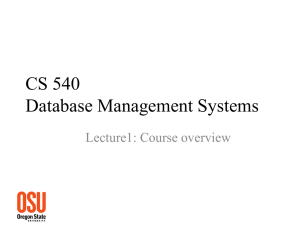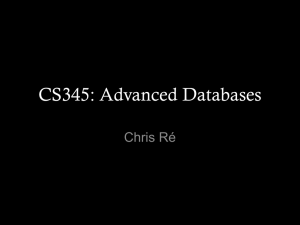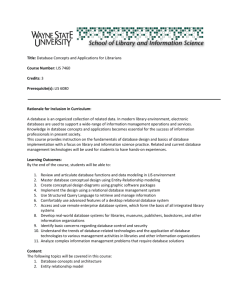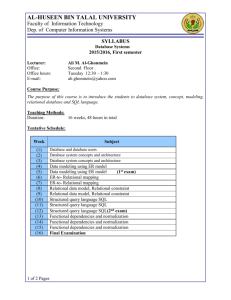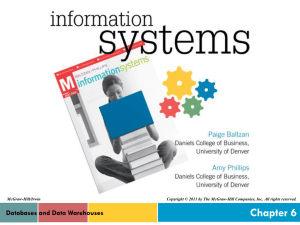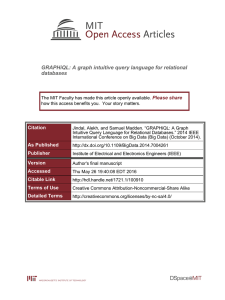Course overview
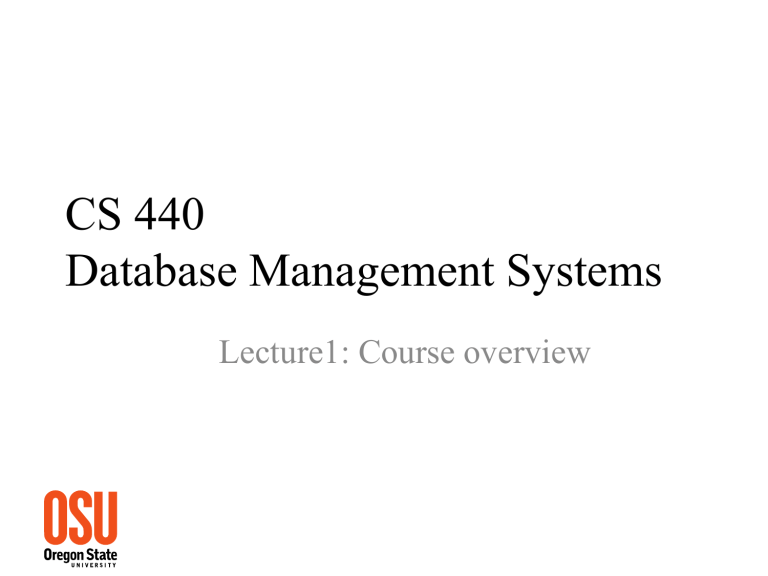
CS 440
Database Management Systems
Lecture1: Course overview
Welcome to CS440!
•
Arash Termehchy
•
Assistant Professor at EECS
•
I nformation & D ata Manag e ment and A nalytics
( IDEA ) Lab @ OSU
•
Research on databases and data analytics
Tell Us About You
•
Name
•
Department & program
•
Technical interests
•
Non-technical interests
•
How do you store and query your data?
This course is about data management
•
Manual processing: 1900
•
Mechanical punch-cards: 1900 - 1955
•
Stored-program computers: sequential record processing: 1955 - 1970
•
Online navigational network databases: 1965 -
1980
•
Relational Databases: 1980 - 1995
•
Post-relational and the Internet: 1995 -
Database management system (DBMS)
•
W. McGee, Generalization: Key to Successful
Electronic Data Processing , Journal of ACM, 1959.
•
Data processing was mostly ad-hoc programs
•
We need generalization (abstraction):
–
Operation
: sort, select part of the file, …
–
File: A sequence of records
•
It makes our systems usable and scalable .
–
More people can use them
–
Easier to extend for large number of large data sets
Generalization is the key
•
How to develop correct and usable generalizations for our data and query?
–
Data & Query Model
– Relational model, Web data model, …
•
How to implement these models efficiently?
–
Database systems internal
– Storage management, access methods, ….
Course objective:
Data models & systems
•
Learn the fundamental concepts and ideas
–
Foundational models, algorithms, and systems.
–
By reading and lectures.
•
Develop systems
–
Apply the lessons learned to interesting data problems.
–
By doing assignments.
This course is not about learning basic concepts in data management
•
We do not discuss
–
ER model, relational model, relational algebra,
SQL, database programming
•
You should know them already
–
Take CS 340
•
We review some of them to refresh your memory.
The Era of Big Data
•
Technological shifts (
Web, cheap hardware, mobile, sensors, …) created a staggering number of enormous data sets.
•
There exists both opportunities and challenges .
Opportunities are priceless!
The story of John Snow
“In the mid-1850s, Dr. John Snow plotted cholera deaths on a map, and in the corner of a particularly hard-hit buildings was a water pump. A 19 th -century version of Big Data , which suggested an association between cholera and the water pump.”
Integrating data sets has saved millions of lives!
Paradigm shifting influence on scientific discovery
• “
The Fourth Paradigm: Data-Intensive Scientific Discovery
”,
Jim Gray
–
Empirical
–
Theoretical
–
Computational
–
Data-centric
•
Sloan Sky Server database is a top cited resource in the field of astronomy.
–
Astronomical observation => database query
Unreasonable effectiveness of data
•
A. Halevy, The unreasonable effectiveness of data , IEEE Intelligence Systems, 2009.
•
More data outperforms complex statistical models in prediction and discovery.
–
Spread of diseases by analyzing Google query log
•
We do not need more complex statistical models.
Traditional systems cannot deal with today’s data sets.
•
Hardon Colider can generate 500 exabyte per day.
•
Sloan Sky Server will soon store 30 terabyte per day.
•
Advances in hardware outpaced DBMS technology.
Traditional systems cannot deal with staggering number of data sets.
•
RDMS used to deal with a single static database.
•
We need to transform and or integrate large number of evolving data sets.
•
Impossible to do manually.
“If you’re an data integration expert, you always find jobs!”
Current systems are not built for scientists and normal users .
“….(in the next few years) we project a need for 1.5 million additional analysts in the United States who can analyze data effectively…“,
-- McKinsey Big Data Study, 2012
“It may take a PhD in computer science to successfully deploy a data analytics algorithm!”
Our plan
•
Learn the fundamental concepts and ideas
–
Foundational models, algorithms, and systems.
–
Textbooks, resources, and lectures.
•
Apply them to new problems
–
Apply the lessons learned to interesting database problems.
–
By doing assignments.
Learning the fundamentals: Lectures
•
Review and discuss the material.
•
Will be available on the course website after the class.
•
Provide the road map for studying
–
The course material can seem overwhelming.
•
Attendance is not required but encouraged .
•
Read the course material before the class.
•
Participate and ask questions!
Learning the fundamentals: Readings
•
Textbooks:
–
Database management systems , 3 rd edition ,
R. Ramakrishnan and J. Gehrke.
•
Cow book
–
Mining Massive data sets , Jure Leskovec, Anand
Rajaraman, Jeff Ullman.
•
Free Online
–
Papers for newer material: posted on the course website.
Learning the fundamentals: Readings
•
Recommended
–
Database systems: the complete book, 2 nd edition, Hector
Garcia Molina, Jeffry Ullman, and Jennifer Widom.
•
The complete book
–
Foundations of databases, Serge Aitboul, Richard Hull,
Victor Vianu
•
Alice book
Learning the fundamentals: Exam
•
Midterm exam in class.
–
Closed books and notes
–
Tests your knowledge of the subjects discussed in the class.
–
40% of the overall grade
–
In class
•
No final exam
Apply your understanding
•
Seven assignments:
•
Announced on Piazza and course website, posted on the course website.
•
Both written and programming.
•
Submit using TEACH
•
Write using word processors and submit in pdf.
•
Start early!!!
•
60% of the overall grade
How to get the most out of the course?
•
Communicate with the course staff
–
TA: Laxmi Ganesan
–
Piazza
• preferred method of communication
–
Office hours
•
Arash: Tuesday/ Thursday 4:30 – 5:30
•
Laxmi: Friday 1 – 2 pm
–
Email the staff for other types of questions
•
Use [cs440] tag in the subject line.
•
Communicate with your peers on course materials and lectures.
•
Check the Piazza and course website for announcements or possible changes in the schedule.
What is next?
•
A review of relational model, relational algebra, and SQL.
•
Assignment 1 will be posted tomorrow night!
•
You refresh your memory by working on some problems on relational model and database design.
